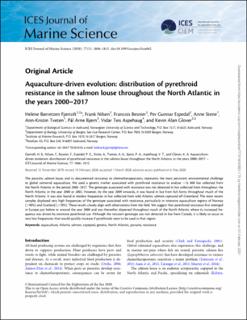| dc.contributor.author | Fjørtoft, Helene Børretzen | |
| dc.contributor.author | Nilsen, Frank | |
| dc.contributor.author | Besnier, Francois | |
| dc.contributor.author | Espedal, Per Gunnar | |
| dc.contributor.author | Stene, Anne | |
| dc.contributor.author | Tveten, Ann-Kristin | |
| dc.contributor.author | Bjørn, Pål Arne | |
| dc.contributor.author | Aspehaug, Vidar | |
| dc.contributor.author | Glover, Kevin | |
| dc.date.accessioned | 2021-05-04T06:26:32Z | |
| dc.date.available | 2021-05-04T06:26:32Z | |
| dc.date.created | 2021-01-18T13:01:50Z | |
| dc.date.issued | 2020 | |
| dc.Published | ICES Journal of Marine Science. 2020, 77 (5), 1806-1815. | |
| dc.identifier.issn | 1054-3139 | |
| dc.identifier.uri | https://hdl.handle.net/11250/2753367 | |
| dc.description.abstract | The parasitic salmon louse, and its documented resistance to chemotherapeutants, represents the most persistent environmental challenge to global salmonid aquaculture. We used a genetic marker associated with pyrethroid resistance to analyse ∼15 000 lice collected from the North Atlantic in the period 2000–2017. The genotype associated with resistance was not detected in lice collected from throughout the North Atlantic in the year 2000 or 2002. However, by the year 2009 onwards, it was found in lice from fish farms throughout much of the North Atlantic. It was also found in modest frequencies in lice collected from wild Atlantic salmon captured off Greenland. The most recent samples displayed very high frequencies of the genotype associated with resistance, particularly in intensive aquaculture regions of Norway (>90%) and Scotland (>70%). These results closely align with observations from the field. We suggest that pyrethroid resistance first emerged in Europe just before or around the year 2000 and was thereafter dispersed throughout much of the North Atlantic where its increased frequency was driven by extensive pyrethroid use. Although the resistant genotype was not detected in lice from Canada, it is likely to occur in very low frequencies that would quickly increase if pyrethroids were to be used in that region. | en_US |
| dc.language.iso | eng | en_US |
| dc.publisher | Oxford University Press | en_US |
| dc.rights | Navngivelse 4.0 Internasjonal | * |
| dc.rights.uri | http://creativecommons.org/licenses/by/4.0/deed.no | * |
| dc.title | Aquaculture-driven evolution: distribution of pyrethroid resistance in the salmon louse throughout the North Atlantic in the years 2000–2017 | en_US |
| dc.type | Journal article | en_US |
| dc.type | Peer reviewed | en_US |
| dc.description.version | publishedVersion | en_US |
| dc.rights.holder | Copyright International Council for the Exploration of the Sea 2020 | en_US |
| cristin.ispublished | true | |
| cristin.fulltext | original | |
| cristin.qualitycode | 1 | |
| dc.identifier.doi | 10.1093/icesjms/fsaa062 | |
| dc.identifier.cristin | 1873214 | |
| dc.source.journal | ICES Journal of Marine Science | en_US |
| dc.source.40 | 77 | |
| dc.source.14 | 5 | |
| dc.source.pagenumber | 1806-1815 | en_US |
| dc.relation.project | Norges forskningsråd: 203513 | en_US |
| dc.identifier.citation | ICES Journal of Marine Science. 2020, 77 (5), 1806-1815. | en_US |
| dc.source.volume | 77 | en_US |
| dc.source.issue | 5 | en_US |

